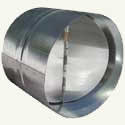A proper HVAC duct sealing evaluation and remediation should include:
- Using diagnostic equipment to detect any escaping air from ducts and joints.
- Sealing any leaks in the ducts and/or duct joints with HVAC grade duct tape or mastic. Note: The product that is sold in every hardware and big box home improvement center called
duct tape
does not have the temperature ratings to maintain its sealing abilities on duct systems. - A complete airflow test of the sealed duct system.
- Application of a minimum of R-6 insulation on all visible duct work in attics, basements and ceilings.
- All appliances in the home, that produce combustion from natural gas or LP should be tested to ensure that gasses are being vented properly. This includes wood burning stoves, fireplaces and furnaces.
- Checking and adjusting return air duct work and where necessary adding additional duct work to balance the pressure in all of the rooms in the home.
Can a homeowner make duct repairs?
In order to detect all the air leaks and other problems in the ducting system a HVAC contractor uses an assortment of diagnostic equipment. These are pieces of test gear that are not something that one would find in even the best equipped home handyman shop. These include:
- Blower door - in order to pressurize and depressurize your home, a HVAC contractor will use a variable speed fan that is mounted in a doorframe.
- Duct blower - to apply pressure to the duct work system the HVAC contractor will use a variable speed that he attaches to the duct system.
- Manometer - to take accurate pressure measurements.
- Flow hood - a mechanical device that attaches to heat and cooling registers in order to measure air flow.
- Infrared camera - some of the more sophisticated contractors may be equipped with video and/or still cameras in order to take thermal pictures of the inside and outside of your home. These thermal images show heat loss in color.
Besides energy cost are there additional benefits of sealing ducts?
The simple answer is, YES!
Benefits of properly sealed HVAC ducting includes:
- Health:
- Improved family health by balanced heating and cooling temperatures throughout your home.
- A lower level of dust, pollen and other potential reparatory ailments, including asthma that can affect the well being of your family.
- Air leaks in the return portion of the duct system can draw in contaminants from other areas of the home which can include chemicals used for gardening and insulation.
- Safety:

Figure 2 - Round backdraft damper
The purpose of the vents that are an integral part of the combustion systems in fireplaces, wood stoves, gas or LP water heaters, furnaces, clothes dryers and other combustion devices is to vent toxic gases such as CO (carbon monoxide). If there are leaks in the duct work, it can result in a depressurization of the areas where those appliances are located. The effect of the depressurization can be to draw toxic gases into the heating and/or cooling duct work and then deliver them through-out your home instead of exhausting through chimneys. This situation is termed a backdraft and is a very serious safety issue for you and your family.
If creating a backdraft is a problem in your home, you can add backdraft dampers to the duct work, as shown in Figure 2.
- Comfort:
- Having all the rooms in your home at the same temperature creates a level of personal comfort for you and your family. Having the ducting system within your home properly sealed will help to balance temperature gradients that exist in your home, making it a much more comfortable place to reside.
- The reduction of air pollutants, even if they do not create serious health problems will also create a more comfortable living environment.
